

The year 1862 was ushered in by
floods, Indian raids and further rumors of secessionist activity
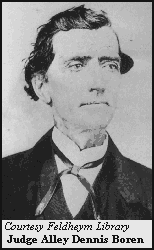 on the desert, rumors which continued until the end of the Civil
War. In January concern had begun spreading throughout the county
because of word recently received that the Army was about to
withdraw from Camp Carleton in San Bernardino.
on the desert, rumors which continued until the end of the Civil
War. In January concern had begun spreading throughout the county
because of word recently received that the Army was about to
withdraw from Camp Carleton in San Bernardino.
ELUSIVE SECESSIONISTS
Upon hearing the news, Judge A. D. Boren wrote the recently-promoted Colonel Carleton in some alarm, as he had learned a secessionist movement was afoot in the area. Boren stated that "Mr. James Leonard was on the Mojave and reports having seen twenty-two armed secessionists and conversed with them, and reports them gentlemen in appearance and bearing, and well outfitted." After receiving several such reports, Carleton sent a dispatch to Major David Fergusson, the commander of Camp Carleton, directing him to send troops in search of secessionists in the vicinity of Lane's Crossing:
You are at liberty to send Captain Fritz with thirty good men over to Lane's on the Mojave to arrest the secessionists reported as being in that neighborhood. Let him take eight days' rations of subsistence. He can doubtless get barley and hay of Lane. Give him sealed orders, not to be opened until he gets to Lane's. In these instruct him very carefully what to do. He is not at all reticent. His men need only know they are to march. Unless you take these precautions, and send the party by night, runners will carry intelligence of your movements by trails across the mountains in advance of the party. |
If the officers involved made any reports on the outcome of the foray, they were not published in the Official Records of the War of the Rebellion, nor were there any newspaper articles announcing the capture of the secessionists, so this may have been yet another futile mission; either there were no rebels, or they had managed to elude the military.
Meanwhile, orders also had been issued for the arrest of Samuel Kelsey, the secessionist agitator from Holcomb Valley. Captain Davidson went after him but was unsuccessful, which prompted Colonel Carleton to write, "It is to be regretted that you allowed Kelsey to slip through your fingers." So Kelsey escaped for certain, and it is possible he took this last reported band of secessionists with him.
INDIAN MARAUDERS
Whatever circumstances Aaron Lane had envisioned awaiting him on the desert when he first moved there, it certainly was not his being in the midst of secret military missions and political conspirators. What he did expect, no doubt, was some trouble with the Indians, but he would get even more of that than he had bargained for. Just as the Mojave settlers had feared, the Indians again became active in raiding area ranches after the closure of the military outposts at the beginning of the war.
Newspaperman Warren Wilson reported that they seemed to have caught "the spirit of outlawry" and were bolder than usual. The attacks continued to escalate, and in February 1862 Lane's ranch was once again a target of marauders:
INDIANS. -- These gentry are becoming troublesome on the Mojave Road. At Lane's, last week, they drove off more of his stock. The troops will soon be in that locality, and will keep them quiet, we hope. |
The raid occurred while Lane was helping another man on the road. There were ten Indians in the party, and they stole three head of cattle from him in broad daylight and right in his presence. Because of the disparity in numbers, he was unable to take any action to prevent them from stealing whatever they wanted.

FLOODS OF 1862
Indians and secessionists were not the only troubles besetting the area; the largest storm of record in San Bernardino County occurred in early 1862. Terrible floods, which began in January and continued into February and March, devastated the entire area.
The February 1, 1862, Los Angeles Star praised the soldiers at Camp Carleton for their help during the floods, saying they "rendered good service in saving the lives of many women and children. Several families who were entirely destitute, were taken to Camp Carleton, and provided with tents and provisions." The February 22nd issue lamented the horrible destruction wrought by the storms:
...our once beautiful valley now present[s] a scene of wild desolation and distress. Large fields of luxuriant grain and beautiful pasture lands, together with the fences, are entirely swept away -- leaving only high sand banks, drift-wood, and other sediment, to mark their former existence. The Agua Mansa, a once beautiful and flourishing settlement, is entirely destroyed -- not a single vestige of anything left to denote that ever such a place existed. The suffering and loss of property of the people of this settlement is indescribable. |
The mountains and desert also were inundated by the rains. The toll road in Cajon Pass washed out and it was closed to the mail and freight-hauling. The normally placid waters of the Mojave turned into a raging torrent, and the flow continued all the way to Soda Lake, which had filled up. A man attempting to cross it became mired in the lake bed, and went to Lane's to get assistance in pulling his wagon out. Lane took a team of oxen and extricated the wagon in what were difficult and dangerous circumstances. According to the Star, this was the first time Soda Lake had filled up since the coming of white men.
With Cajon Pass cut off and Soda Lake nearly impassable, the Mojave River settlers were virtually isolated, and while it is probable they all sustained some damage from the storms, Lane himself would not have incurred too much, perched as he was fairly high up on the bank of the river.

COVERT OBSERVATIONS AT CAMP CADY
In March 1862 Camp Carleton was abandoned in San Bernardino, but the Army kept a watch on the desert, especially since information had been received that a large body of men was camped east of Beale's Crossing. Cavalry Lieutenant Nathaniel P. Pierce of the 2nd Cavalry, California Volunteers, was ordered to proceed to the abandoned Camp Cady site with ten men, where they were to hide themselves and their animals inside and covertly observe any movements along the Mojave Road.
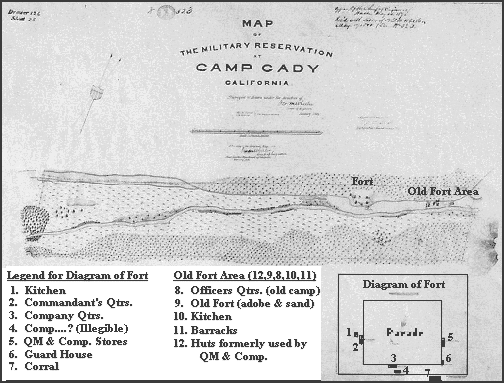
|
THE LEGEND AND THE CORRESPONDING NUMBERS ON THE MAP AND FORT DIAGRAM WERE TOO SMALL TO READ, SO THE INFORMATION HAS BEEN TYPED IN |
Pierce reported that the eight-day trip to the camp was without incident, but he did hear news on the road of suspicious activity, which included sightings of men running wagonloads of gunpowder into Utah, probably intended for Brigham Young's militia:
[I] arrived at Camp Cady on the 14th of April, A. D., 1862, seeing and hearing of nothing unusual on the route, except at Lane's Crossing of the Mojave, where I was informed by Mr. Lane that a wagon loaded with powder had crossed there a few days previous, said to be going to Salt Lake. I remained at Camp Cady until the 24th of April, seeing and hearing of nothing unusual, and meeting no parties that I could suspect of treasonable intentions toward the Government. On the 24th I left Camp Cady for Camp Latham, and on arriving at Lane's Crossing...I was informed by Mr. Lane that during my absence...another wagon loaded with powder, said to be for Salt Lake, had passed. I was informed by the parties keeping the toll gate at Cajon Pass that armed men in small parties had been passing through all the winter and spring. |
This is the only report in the War of the Rebellion that cites Lane at all. It seems strange that with the Army's receiving so many letters and reports on sightings of secessionist activity out on the desert, sending at least two expeditions out in as many months to investigate the reports, that they did not utilize Lane to any greater extent. Because of his vantage point on the Mojave River, he had to be one of the most knowledgeable persons regarding movements on the desert.
In May of 1863 Fort Mojave was reactivated. With its reinstatement, there were few problems with the Indians in the vicinity of the fort, but in other parts of the desert they became more and more troublesome, and it was reported in August that Aaron was even temporarily forced from his home:
The Indians about Camp Cady [and] Lane's Rancho, are becoming quite hostile, Mr. Lane himself being compelled to pull up stakes and leave. It is to be hoped the officers at Fort Mojave will attend to this matter, and see that the settlers in that section receive the protection they were sent there to impart. |


TRAVELERS INCREASE ON THE DESERT
While the Indian hostilities were increasing, so was the number of travelers on the road, and to add to the traffic were the latest mining discoveries in Arizona. Excitement was high over these new finds. In a letter dated September 7, 1863, Los Angeles was likened to the "palmy days" of '49, with "gold excitement, rush of travel and high old times generally." The writer estimated that within five days at least 200 people had left the city for the gold mines, and they were "still leaving, every hour."
The increased traffic was certainly beneficial to Lane, who was situated right on the road where much of it must pass: miners needed provisions, freighters used the road, there was a mail express, and the military had returned to Fort Mojave.
Lemuel Clark McKeeby and six other miners passed through Lane's on a trip out to the El Dorado Canyon mines north of Fort Mojave, and then stopped again on the return trip. In McKeeby's reminiscences he notes that Lane is a bachelor, and is living alone.
McKeeby also remarks that "on our arrival there that evening we were provided with fresh pork, this being all the tame meat to be had at that place, no cattle or sheep. However, the hog meat was all right and we enjoyed it hugely." McKeeby does not say why Lane only had hogs. The Indians may have stolen the rest of his larger animals, leaving just the hogs, which could not be herded so readily. Or perhaps he had moved his more vulnerable stock temporarily to some safer spot with friends in San Bernardino.
LANE GETS NEW NEIGHBORS
In the spring of 1863 a new family of desert settlers took up temporary residence at Lane's. At that time, according to a sworn statement by Deputy Assessor Sydney Waite, a Mr. E. P. Prothero was living on the Mojave River in improvements on public land claimed by Aaron Lane. Edward Powell Prothero was a Welshman who, after converting to Mormonism, emigrated first to Utah and then to San Bernardino. The added security provided by Prothero and his family was a blessing, especially since he had two of his adult sons, John and James, still living with him.
The stay was a brief one, however, as the Protheros soon finished construction of their own homes at the Cottonwoods. The following year Edward and his son, John, are shown in the Auditor's Assessment Book as each having improvements on state land at the Cottonwoods.
In 1864 a cattle concern moved in near Aaron. They had a large herd with attendant cowboys -- always good neighbors to have if there is trouble with the Indians.
The herd had been moved to the Mojave as the result of a long drought which had devastated the prominent ranchers in Southern California. The drought had started back in the late 1850s, and by 1862 the ranchers had begun losing their cattle to starvation. This is one of nature's ironies: in the midst of one of the worst droughts in Southern California history, there occurred the greatest storm.
One of the stockmen, William Wolfskill, whose familiarity with the Spanish Trail extended back to 1830, had traveled the Mojave River valley in the summer of 1863 on his way to Tonopah to look after some mining interests. He noticed the verdant grasses were growing well despite the lack of rain, and determined to bring his cattle here if the drought continued.
The dry weather persisted and by January of 1864 many of the ranch animals looked like skeletons, and large numbers were dying. Some ranchers had already lost half their stock, and it was feared that many more would be lost. The decision was made to move the cattle to the desert, thus a camp was established near Lane's.
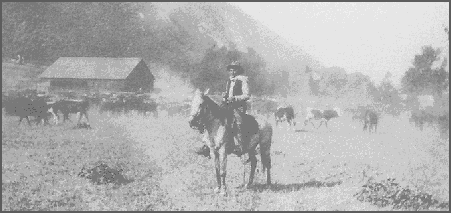
J. E. Pleasants, one of the cowhands employed by William Wolfskill, later wrote a story of the drive, which appeared in the March 1930 issue of Touring Topics. He writes that beginning in January 1864 the ranchers organized a cattle drive to the Mojave, made up of around 3,000 head plus several hundred horses. The herd was moved about 500 head at a time, traveling only 15 miles a day due to the condition of the stock.
After resting a few days in San Bernardino, the drovers entered Cajon Pass, where they encountered sleet storms and very cold winds, and often there were icicles hanging from the horses' bridle bits. The herd survived the inclement weather in the pass, for the most part, and by the end of March they were settled on the Mojave.
Pleasants mentions that rancher John Rowland also had cattle in the drive. Rowland, according to Pleasants, was Wolfskill’s partner in the Rancho La Puente, although they kept separate brands.
Pleasants speaks well of Aaron Lane, but with the intervening 66 years since the cattle drive, he recalls him as "John" Lane:
Our neighbor on the Mojave was John Lane of Lane's Crossing, a trading post which he kept at the first crossing of the Mojave River.... John Lane was a true frontiersman and a genial host, and many a tale of hair-breadth escapes and desert hardship has doubtless been told by the campfires of the emigrant and teamster under the cottonwoods. |
Pleasants and the other cowboys had set up camp several miles down-river from Lane. The stock was contented, having plenty of forage along the river; and because it was barren desert all around, there were few strays. The men made acquaintances with the many travelers and freighters stopping to refresh their teams on the abundant grass and water. One of the main economic forces that permitted the way stations to survive was the freighting industry. The freight wagons, usually with six to eight span of mules each, came in from Salt Lake City early in the fall. The teamsters gathered in big encampments while they rested their animals for a few days before taking to the road again.
Besides the freighting traffic, Pleasants states, there was still considerable immigration from the East along the Salt Lake Road. All this bustle kept the cowboys on the Mojave River from getting too lonely.
This cattle outfit was very well run. The cowhands even managed a wary truce with the local Indians. There had been many Indians around the camp, but the cowboys always supplied them with beef whenever they needed it, and relations were good. The drovers knew the desert Indians could be treacherous, but sympathized with the conditions under which they had to survive, subsisting mostly on rabbits, rats, insects and mesquite beans, when they were lucky enough to get them.
The Indians gave Pleasants quite a scare one morning when he and a companion were out scouting the desert. The two men were confronted by about 20 Indians who wanted tobacco, but the cattlemen had not taken up the habit, so they were unable to satisfy their demands.
The Indians became hostile and insolent, and actually searched the cowhands and their gear, thinking they were lying about not having any tobacco. When they failed to find any, the Indians turned sullen and went away muttering, "No tobacco smokum; no good hombres."
On November 16, 1864, steady rains began that continued throughout the winter season, and the terrible drought was broken. In April of 1865 the ranchers began to take the cattle back home, and all were returned by the middle of May. The ranchers lost 25 percent of their stock in the move to the desert, but the loss was 75 percent for those who did not come. Pleasants goes on to say that the losses to the cattle industry, which was predominant in California prior to 1864, were so great that it never recovered, and many fortunes, large and small, were gone forever.
By the fall of 1864, new residents had moved even further down the river than the Nicholson and Prothero families, who were still at Point of Rocks and Cottonwoods. Albert Jacoby had moved to Grape Vines, and the Alcorn family was living at Forks of the Road.

LANE'S NEIGHBORS FEND OFF INDIANS
It was at this time that the desert Indians launched a significant attack directed at these citizens. On November 14th, Nicholson and the heads of the other three households downstream, together with three men named Daniel Cline, F. M. Moffatt and John H. Haven, all signed a hurriedly written plea for help to Sheriff Benjamin F. Mathews:
To the Sheriff of San Bernardino County -- We the settlers of Mohave River, do sincerely petition to the Citizens of this County for help to drive the Indians off, as they are here in considerable numbers at Camp Cady. They are killing stock of all Brands. We had a fight with them yesterday Evening. They all appear to be armed with good guns and fight desperate.The Citizens of Camp Cady are all at the forks of the Road assembled for self protection. |
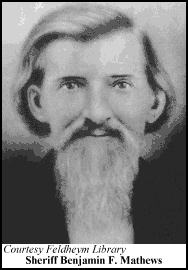
Mathews received the letter the next day, and sent a notarized copy to the commander of Drum Barracks in Wilmington, Colonel James F. Curtis of the 4th Infantry, California Volunteers. Mathews also wrote a cover letter stating he had no other knowledge of the incident, because the person who delivered the letter had received it from someone else at midnight and he had not bothered to ask the messenger for any particulars of the raid. He added that a small group of armed citizens was preparing to leave in the morning, of a size "sufficient I think to keep the Indians at bay until Government Troops can arrive."
Neither Aaron Lane, nor Pleasants and the other cowboys, were listed on the petition. Just who finally did run the Indians off -- the local citizens' militia or the military -- is unknown, as no further details could be found on the episode.
REPORTS FROM JANE ROUSSEAU
The settlers had good reason to fear for their lives if reports from Mrs. Jane Rousseau are correct. Dr. and Mrs. Rousseau traveled the desert in the final months of 1864 with a wagon train leaving Utah and bound for San Bernardino.
In her diary entry for December 4th she wrote that she was at a place where Indians had slain three men who had been serving as caretakers for a mine located there. The killings had occurred eight weeks earlier. According to the diary, there were four houses and a quartz mill at the site, which has since been identified as Salt Spring.
Mrs. Rousseau reported on several occasions that she was frightened by Indians, who were quite bold and came right into their camp. There must have been enough people in the party that the Indians did not attack.
Her companions, who included the Earp and Curtis families among others, ran out of provisions and became exhausted prior to reaching Bitter Springs. The animals were so fatigued that on December 6th two members of the party set out on foot to seek help from the Mojave River settlers. Three days later the rescue party returned with the much-needed supplies, but they also carried reports from the inhabitants on the river that the Indians in the area were menacing and thought to be particularly hostile.
As the group continued on towards the river, a man, identified only as "the old gentleman who keeps the ranch about 30 miles from Bitter Springs," met them with some additional grain for the horses. Finally, the Rousseau family, who had split from the others over a disagreement, managed to make it to the river, thanks to their refreshed horses.
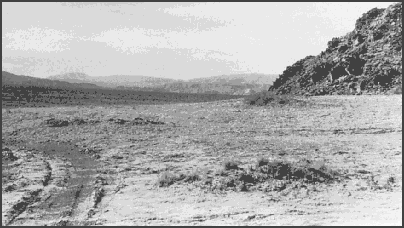
The Rousseaus stopped at the Alcorn ranch at Forks of the Road, and while there Dr. Rousseau attended "to a young man about to die, a son of Mr. Allcorn...." Mrs. Rousseau commented that "they seem real clever folks, the old gentleman is from Kentucky, his wife from South Carolina. They are secessionists...."
She also mentions Jacoby and the Nicholson family on her trip up the river, but she does not write about the settlers' recent scare by the Indians at Camp Cady or of the outcome of their request for help from Sheriff Mathews. It seems likely that had the U. S. Army sent out a patrol as requested by the sheriff, the news would have been fresh enough to have been entered into her diary.

THIEVING BANDS ALL OVER THE DESERT
The Los Angeles Star, which had given good coverage of the desert news considering the small size of the publication, would undoubtedly have had something to say on the matter, but the paper had ceased operating in October 1864. This was particularly regrettable because the Irish editor, Henry Hamilton, had developed a friendship with Aaron Lane, and his loss is akin to a blackout. Not until Hamilton begins the San Bernardino Guardian in February 1867 are regular reports again given on Lane and the activities on the Mojave.
Three months after the Indian attack on the Mojave River settlers, a gang of horse thieves staged some impressive raids of their own in the Southland. In February of 1865, a company of "renegades, thieves and cutthroats" on their way to Arizona began by raiding some ranches in the Duarte area, stealing two herds of 50 horses each.
They continued along the foothills to the mouth of Cajon Pass, where they stole the entire herd from Martin's Ranch. The gang then headed out into the Mojave Desert and escaped with their ill-gotten booty. This rather significant theft is noteworthy in that it demonstrates that horse stealing was still a serious problem in Southern California.
Just following the February horse theft, Colonel Curtis of Drum Barracks made a trip to the desert himself for the purpose of seeing personally the extent of the Indian troubles along the Mojave River. He reported that the settlers and travelers told him the Indians had been gathering in bands consisting of anywhere from a dozen to thirty men, and would descend down from the mountains to "steal stock, rob houses, lay forced tribute on travelers," and threaten lives.
In one instance they killed two men living at the Caves, eighteen miles east of Camp Cady. The Indians were particularly eager to arm themselves with guns and ammunition, and they had secured some of the best rifles, shotguns and pistols.
The officers at Fort Mojave verified these reports, saying that the entire expanse of road from the upper crossing to Rock Springs, which was within 40 miles of the fort, was "infested" by thieving bands of Chemehuevis and Paiutes. Colonel Curtis had left Captain Benjamin West's Company C at Camp Cady with instructions to send out scouts to look for any activity by the "hostiles."
On March 1st, Captain Edward Bale, 1st Battalion of Native Cavalry, California Volunteers, was sent from Drum Barracks to relieve West and to make headquarters at Camp Cady. Thirty of Bale's soldiers were mounted, and the rest were on foot.
Captain Charles Atchison at Fort Mojave was ordered to arrest 20 of the "principal men" of the Chemehuevis, and to keep them on short rations until the parties responsible for the slayings at the Caves were surrendered over to him. Captain Bale received written orders, dated March 3rd, that gave him explicit directions on how to handle the protection of the Mojave River:
CAPTAIN: The colonel commanding district directs that until further orders the headquarters of your company will be at Camp Cady. While encamped there you are charged with the duty of patrolling the road and keeping it clear of Indians from Lane's upper crossing of the Mojave to Soda Lake, and particularly to keep Indians away from the watering places.... You will keep a camp guard of at least fifteen men, and the balance of the command will patrol the road constantly, as above directed. |
Camp Cady had once again become active, and the very next month -- April 23rd is the date generally accepted for the event -- the camp would be reestablished as a permanent military post.
On April 16, 1865, the day President Lincoln was assassinated, Colonel Curtis sent a dispatch requesting that more troops be sent in order to handle impending danger from two fronts. One serious threat was the bands of hostile Indians who were still roving through the County of San Bernardino and committing depredations on the Mojave Road up to within a few miles of the County Seat.
The Colonel's other concern was the reaction of the secessionists in the area. Even though a formal surrender had been signed two days previously, the death of the President was expected to rouse some of the secessionists into action, and the Union people in San Bernardino had heard rumors that an operation of some kind was being planned.
The rumors escalated to the point where Governor Frederick Low wrote to Curtis saying that he was convinced there was reason for concern. As it turned out, there was a band of secessionists who left from the vicinity of Visalia.
On their way through Tehachapi they stole several horses and then crossed the desert north of the mountains into the Mojave River area, where they hid out in the neighboring hills between there and Holcomb Valley. However, on May 12th Colonel Curtis was able to report that Captain Atchison appeared on the scene in a timely manner, and had succeeded in scattering the would-be raiders.
This final episode was the end to the Civil War years on the Mojave River. During the war Aaron Lane, as a Northerner and ex-Army soldier, had remained steadfastly pro-Union, and he testifies to that fact in his pension records. He is also reported in the newspaper as being loyal to the U. S. Government. In fact, judging from the articles in the Star, he was doing his part in the effort to subdue the "secession spirit."
Just as the war was ending, Aaron decided there were greener pastures on the Mojave, and he sold his claim to Dr. Woodville M. Andrews and his wife, Sophie B. Andrews. The deed, dated April 6, 1865, states he was selling:
...that certain portion of Land lying and situate on the Mojave, County of San Bernardino, State aforesaid, and described as follows, to wit: ...Being the possessory Claim of the party of the first part, situate at the first crossing on the Mojave River, in San Bernardino County, State of California. Together with all Houses and fences and all my rights, privileges and franchises thereto incident....And also all singular the tenements, hereditaments and appurtenances thereunto.... |
After six and one-half years at the upper crossing, Aaron moved a few miles downstream, where he started a new enterprise on the rich farmland in the overflow of the Mojave River.

 PAGE
1|
2|
3|
4|
5|
6|
7|
8|
9|
10|
11|
12
PAGE
1|
2|
3|
4|
5|
6|
7|
8|
9|
10|
11|
12

